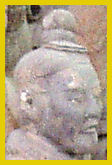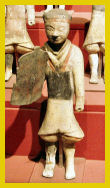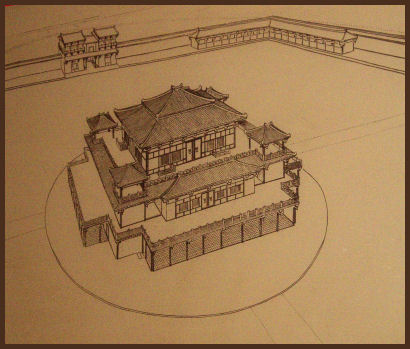A BRIEF HISTORY OF THE QIN DYNASTY
Before Ying Zheng took over the throne of the Kings of Qin in 246 BC, the kingdom had been expanding because
- it was semi-independent of the main state, the Zhou, which ruled at that time
- it was based around the Wei River Valley and played an important part of the main route of trade and commerce through Central Asia which the government encouraged and therefore made it wealthier. This trade route was later to become known as the Silk Road
- it's government was organised on the basis of merit and good service rather than doing favours for people in power
- immigration was encouraged particularly for educated and talented people from other areas and for farmers willing to work on land which, at that time, was not being used. This is one of the reasons that we see so many different faces on the terracotta warriors - they came from all over the empire
- harsh punishments were given out to people who would not work including execution which, not surprisingly, made people work
- the King of Qin divided his territory into counties and appointed government officials to run them rather than allowing his nobles to do so and this meant that the nobles had no jobs, no money and, most importantly, no base for their own power
- he also made the nobles live in his capital city so that they could not establish rival power bases out in the provinces
- the kingdom was slowly expanding both to the north and the south, making allies of other kingdoms and, eventually, defeating the Zhou in 256 BC
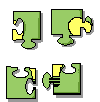 Facts and Figures
Facts and Figures
In 230BC, when he was 29 years of age, Ying Zheng began to attack and conquer the other states around him. This is the period in Chinese history called The Period of Warring States. He conquered the
- Han in 230BC
- Zhao in 228 BC
- Wei in 225 BC
- Chu in 223 BC
- Yan in 222 BC
- Qi in 221 BC
It was after all these successes that Ying Zheng adopted the name Qin Shi Huangdi. Below are two maps which show the territory he held. The first is a simple, hand drawn sketch map of China showing all the places mentioned on this website. The second is a detailed map of the Qin Empire from http://www.fsmitha.com/h1/map08ch.htm
The emperor continued to conquer new territory and eventually controlled land from the modern day Mongolian border in the north, to Tibet in the west, northern Vietnam in the south and the sea to the east - what is, today, modern China. He rewarded his top generals and gave them great favours, even allowing them to be buried in substantial tombs with wide lands around them. This tomb, one of the few remaining untouched from the period, is an example. Around this type of tomb material goods for the afterlife were buried.
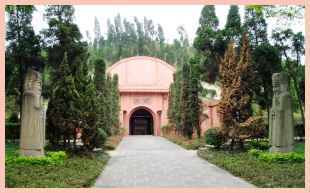
This tomb is in Chengdu, and was the burial place of the general, Yong Li.
One of the reasons this tomb is so important is that it has not been damaged or raided by tomb robbers and it clearly shows the barrel vaulting style of building, with the tomb in the middle (foreground)
Over the next two decades the emperor changed many things to strengthen the unity of his Empire. He
- set up a new capital in Xianyang of which nothing remains today but it was quite large with many buildings, pavilions, courtyards, wide roads and general housing
- in the capital he also had many public buildings for the people to use such as bath houses and meeting halls, temples and pagodas. There was even a library but it had only a limited range of books in it that he had approved
- he ended feudalism in China and created 36 counties run by government officials, not the nobility
- he made everybody equal under the law (but this did not always work)
- he set common weights and measures so that everybody knew what the standard was and it also helped with his taxation system
- he set up mints for making coins for the empire so that everybody used the same set of money and knew its value. The basic coin, the banliang, remained in circulation until the end of the Imperial period in 1911.
- he improved roads and canals across the empire which helped trade and commerce as well as the movement of his armies
- he extended a dam and irrigation system begun on the Minjiang River during the Warring States period at Dujiangyan in Guanxian County, Sichuan Province which still exists today and still functions properly
- he set a common width for carts so that the new roads could be built to last longer
- he simplified the characters used in Chinese writing to make a common set to be used across the empire
- he encouraged the development of technology including iron tools to improve farming and fighting - when he conquered the Qi kingdom he acquired large iron ore mines and the knowledge and technology of the Qi people to blacksmith the iron into tools and weapons which made him even stronger.
However, he also did things which upset people
- he made the rule of law more important than the rule of tradition and part of that was that
- the nobles lost all their power and were forced to live in Xianyang with the emperor so that he could keep an eye on them
- he had many books on history and philosophy destroyed in 213 BC so that nobles and scholars (educated people) could not use them to learn about the past and, perhaps, rise up against him
- the following year, 212 BC when the scholars complained he had 460 of them executed by burying them alive and there is some evidence to say that he had another group of 700 scholars killed a short time later when they could not come up with the elixer for immortality
- he taxed everyone very heavily to pay for his palaces, his public works and his army though, in reality, it was the common people who paid the most in taxes as the rich and powerful found a way to avoid paying
- he made the common people work on his projects such as the highways, the canals and the Great Wall which sometimes affected the harvest and led to famine.
- he set up more than a dozen horrible ways of giving capital (killing) punishments including chopping in two at the waist, decapitation, drowning, boiling to death and even killing the rest of the criminal's family in front of the criminal and then killing the criminal
- he also used mutilation, imprisonment, exile and hard labour on his public works as punishments
 Facts and Figures
Facts and Figures
According to the official records of the time, in the ten years after uniting China the Emperor had
- half a million men conscripted to guard the south-eastern borders of present day Jiangxi, Hunan and Guangdong provinces;
- half a million men forced to work on the Great Wall
- 300 000 men sent to the northern frontier to guard against the Huns
- 700 000 men conscripted to build the Apang Palace and the Emperor's mausoleum
This made up almost 10% of the total population of his empire and caused much suffering because these men were taken away from their families and their work..
An artist's impression of Qin Shihuangdi's palace at Xianyang, from the Shaanxi Provincial Museum, Xian |
|
|---|
When Shi Huangdi died in 210 BC some of his palace officials hid the fact and tried to take over by placing a younger son on the throne. They sent the Emperor's eldest son a note, supposedly from the Emperor, ordering him to kill himself and he did so. This left the throne open to the younger son. However, Shi Huangdi left a magnificent heritage - his burial mound and surrounding structures with its Terracotta Army and surviving remnants from his era.
When the rest of his empire found out about ShI Huangdi's death many people rebelled against the new emperor.
- The nobles tried to get their power back
- The peasants killed their local officials and destroyed taxation records so that no-one would know who owed what or who was supposed to be working on the public works as forced labourers
- Some local officials began to gather around them small armies for both defence and attack
One of the local officials who gathered an army around him was an ex-policeman, Liu Bang, who made some very good alliances with other families and officials and emerged from the rebellions as the Prince of Han. He soon took over control of more and more territory and, by 202 BC had become so strong that he made himself emperor of China and began the Han Dynasty.
